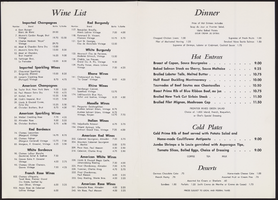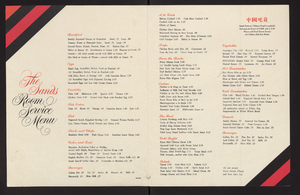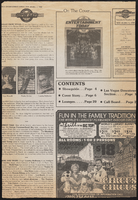Search the Special Collections and Archives Portal
Search Results
Ruby Duncan Photograph Collection on Operation Life
Identifier
Abstract
The Ruby Duncan Photograph Collection on Operation Life (1970s-1980s) is comprised primarily of photographic prints with some corresponding 35 mm negatives of Ruby Duncan and other Operation Life organizers, as well as important organization buildings. Materials include photographs of Ruby Duncan, Aldine Weems, Renee Diamond, and Jack Anderson in the original Operation Life Las Vegas, Nevada Operation Life headquarters and the regional office in San Francisco, California. Also pictured are other employees and beneficiaries of the organization at a Christmas Party.
Archival Collection
Vassili Sulich Photographs
Identifier
Abstract
The Vassili Sulich Photographs depict dancer and choreographer Vassili Sulich from 1950 to 2011. The photographs primarily depict Sulich dancing in ballets in France, Croatia, Germany, England, and the United States. The photographs also depict ballets choreographed or directed by Sulich at the Nevada Dance Theatre, which he founded in 1972 in Las Vegas, Nevada.
Archival Collection
Jewish Nevada Records
Identifier
Abstract
The Jewish Nevada Records document the organization's philanthropic activities in Las Vegas, Nevada from 1978 to 2018. The majority of the collection represents the organization's activities under the name the Jewish Federation of Las Vegas. The collection includes administrative files, annual reports, marketing materials, donation records, video recordings of interviews and events, and audio recordings of board meetings. The collection also includes photographic prints and negatives of events hosted by Jewish Nevada.
Archival Collection

Stavan Corbett oral history interview: transcript
Date
Archival Collection
Description
Oral history interview with Stavan Corbett conducted by Nathalie Martinez on November 5, 2018 for the Latinx Voices of Southern Nevada Oral History Project. Barbara Tabach and Rodrigo Vazquez also participate in the questioning. Stavan Corbett is a member of the Latino community who has served as an educator and politician in Las Vegas. Growing up in Las Vegas, Stavan was exposed to various environments that all helped him shape his Latino identity. Stavan was able to appreciate the Catholic and Jewish cultures as well. During the 1970s and '80s his experiences with first and second generation Latinos played a large role in his identity formation, especially as a student. He was the first in his family to graduate from high school and college. Stavan worked in the hotel industry and moved on to work with troubled youth and eventually become a member of the Nevada State Board and the Clark County School Board. His continued work with the Latin Chamber of Commerce has also allowed him to be involved with the Latino Youth Leadership Conference. Subjects discussed include: Identity Struggle, Interracial Relationships, Working in the Hotel Industry, Clark County School District, and Cultural Assimilation.
Text
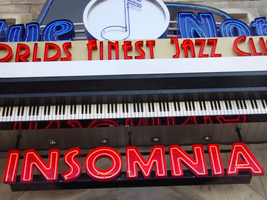
Photographs of Blue Note signs, Las Vegas (Nev.), 2002
Date
Archival Collection
Description
Site address: 3663 S Las Vegas Blvd
Sign owner: Blue Note International: Father & Son team of Danny and Steven Bensusan
Sign details: The Blue Note is located a short distance east, down Harmon Ave., on the north side of the street, facing south. It is part of the Aladdin Hotel Casino. A vacant lot resides on the corner, and is the only thing that separates the Blue Note from the Strip. Signage for the property includes two logo wall signs on the west wall of the building, a vertical blade sign and an entrance sign over the main port to the establishment.
Sign condition: Structure 5 Surface 5 Lighting 5
Sign form: Fascia
Sign-specific description: Just east off of Las Vegas Blvd, down Harmon Ave, lies the entrance to the "Blue Note: Jazz Capital of the World." The Blue Note is actually part of the Aladdin property, residing in the eastern most wing of the building, on the south side of Harmon. The majority of the signage hangs on the front of the building, which faces south toward Harmon Ave., with additional signage on the west face of the structure that extends from the Aladdin property. A vacant lot on the north east corner separates the Blue Note from the rest of the strip. The structure of the building and the design of the signage are juxtaposed with the building still being finished in a Persian Palace theme. While the signs are reminiscent of roaring twenties style font and theatre front design. Several different types of signs adorn the Blue Note. Two wall /logo signs hang on the west side of the building, while a sculpted entrance marquee, a hanging logo sign, and a vertical blade sign hung on the south side of the building. The west wall logo sign is composed of blue channel letters spelling the text " Blue Note," separated by a circular cabinet with a tube of neon bent to emulate the shape of a musical note placed in the middle. Five steel bars just out from either side of the cabinet. Below the text, a white steel cabinet with rounded ends, support a thin set of blue channel letters reading, "Jazz capital of the world." Further to the right a set of pink channel letters rest upon the upper portion of the corner of the structure. The letters are filled with pink neon. Along the South face of the building the first sign, hung in close proximity to the southwest corner, a vertical blade sign sits on a radius base of shaped molding jutting out of the wall. The actual body of the sign is a double backed cabinet finished in polished aluminum, with blue pin striping along the edges as well as along the rounded edge of the top. Near the top of the sign, the same rounded cabinet seen on the west wall of the structure, is integrated into the blade facing east/west. The cabinet is thicker in width to compensate for the width of the actual sign. The edges of the steel structure are painted in the same blue tone. The afore mentioned blue neon tubing fashioned into the shape of the note resides in this cabinet also. Along the east/west sides of the sign the text "The Blue Note," runs vertically from top to bottom, in blue channel letters only interrupted by the circular cabinet. The panel, which the text resides is painted white. Along the edge of the blade, which faces south, the text "Blue Note" is spelled vertically in blue channel letters. Sitting along the edge of the base, which the sign sits on, thin red channel letters stand almost independently, wrapping around the radius of the base. Starting on the west side of the sign and finishing on the east side, the text reads "Club & Cafe." These letters are filled with tubes of red neon. The letters are attached to a backing radius band of metal appearing to be gold. Further down the face of the building the main entrance to the building plays host to an overhead marquee/logo sign incorporating sculptural elements as well. Directly in the center of the composition, a long horizontal cabinet plays host to the red channel letters filed with red neon, reading, "World's Finest Jazz Club." Sitting on the top edge of the cabinet the same configuration of the Blue Note logo sign along with the circular cabinet, rests in front a sculpted piece of black steel. This piece of black painted steel is cut to appear as if it is the open top to a piano. Along the interior edge of the lid tubes of blue neon form a blue border. Between the piano top and the Blue Note logo, a horizontal steel grate serves as a divider as well as support for the blue channel letters. This entire section sits on a long horizontal ledge composed of a long polished steel section with a long LED message center just below that. Slightly recessed below the message center another width of overhang constructed of steel is painted to appear as if it is made of piano keys. Along the wall, just above the door, the pink channel letters read "Insomnia" with pink neon on the interior.
Sign - type of display: Neon
Sign - media: Steel; Fiberglass
Sign - non-neon treatments: Paint
Sign environment: Situated just east off the strip, down Harmon Avenue, the Blue Note is the only attraction in its immediate area. Even though it is part of the Aladdin complex, the closest property is the Harley Davidson Cafe on the south east corner of Harmon and Las Vegas Blvd At night, the property loses its Arabian Nights architecture emitting a sultry glow of neon. It is hard to miss, if a pedestrian peers down the street while traveling north or south, on the east side of the strip. During the day, the architecture helps to blend in the property to appear as it is, part of the Aladdin.
Sign manufacturer: YESCO
Sign - date of installation: 2000
Sign - thematic influences: The building itself is part of the actual Aladdin property, so the faced of the structure is themed in the manner of an ancient Persian city. It is an interesting juxtaposition for the sleek, modern finish and colors of the signage, with the organic facade of domed towers and stone facade. The Blue note signage is themed around the subject of music, specifically Jazz and Blues music. The blue hue of the neon, and the cabinet containing the crafted musical note are all evidence of this. The blade sign is thematically influenced by marquee building signs for theaters and music clubs from the first part of the century, specifically the forties and fifties. Such examples that utilized a similar designed blade sign were properties from the 1930's 40's and 50's such as The Boulder Club, The Pioneer Club, and the Las Vegas Club.
Surveyor: Joshua Cannaday
Survey - date completed: 2002
Sign keywords: Fascia; Neon; Steel; Fiberglass; Paint
Mixed Content
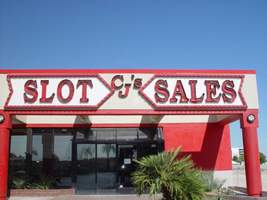
Photographs of Arby's and Guinness World of Records Museum signs, Las Vegas (Nev.), 2002
Date
Archival Collection
Description
Site address: 2776 Las Vegas Blvd, 2780 Las Vegas Blvd
Sign owner: Arby's: Schultzen and Harry Sax, Guinness: ?, Cj's: PDS Gaming used to be Carl Fredrickson
Sign details: Located in a small lot on the west side of the strip, north of the giant Circus Circus pylon, and just north of the Arco AM/PM, the Arby's fast food establishment shares property and a sign with Guinness World of Records, and CJ's Slot Sales Facility. The Arby's is located in the front of the lot facing the strip, flanked on either side by drives. The "L" shaped structure for the other two establishments lies in the rear, western portion of the lot. To the north of the property, is vacant desert, stretching to Sahara Ave. To the south is Fantasia Gifts. Text signage adorns both structures, as well as a small pylon on the front northeast corner of the property. This sign is located in close proximity to the street.
Sign condition: Structure 4 Surface 3 Lighting 3 The structural integrity of all the signs on the property seem to be stable and in decent repair. The surface of the Guinness channel letters is faded, and showing patches of white. The lighting on the Guinness sign does not work, but the main pylon is functional. Even though CJ's slot sales are not present in this location any more, the text on the pylon for CJ's is functional and animating. The back-lit letters on the Arby's facility are functional, but the red channel letters are not.
Sign form: Pylon; Fascia
Sign-specific description: The north and south sides the Arby's building contain red painted, channel letter text, reading "Museum & Gift Shop," with a lengthy channel arrow underlining the above text and pointing toward the buildings located at the rear of the property. The pylon sign is on the north end of the property, across the drive from the establishment itself. It is basically a two-sided, vertically standing rectangle, divided into two sections by a narrow LED message center. The top half belonging to Arby's and the bottom half designated for the Guinness establishment. Both are placed on a smaller section, which serves as the base. The top half is finished in mirrored panels, providing a reflective surface for the Arby's logo. The insignia for the establishment is the outline of a ten-gallon cowboy hat, with the text spelling "Arby's," displayed cutting through the outline onto either side of the object. The entire logo is constructed of crafted channel raceways. Two separate yellow pieces form the top and bottom portions of the hat, while the text is created in orange. All the channels are filled with incandescent bulbs, and outlined in neon. The bottom portion of the sign is also two sided with, a yellow tinged face providing space for a four lined series of text. The text reads, "Guinness World of Records Museum," in red channel letters, and filled with neon, of the same color. The entire sign itself is bordered in neon. The remaining exposed face of the cabinet is finished with mirrors also. The bottom edge of the cabinet is a sloped mirrored surface which angles down into thinner, but equally wide base that contains signage also. In polished channel letters, internally lit with red plastic faces, the text "Slot Sales," resides and contains a small arrow of the same design on the western edge of the sign. A black internally lit cabinet sits beneath that. The sides of the lower portion are mirrored panels as well. The wall signs of the building at the rear of the property, are similar to those seen on the north and west sides of the Arby's establishment. The signs run parallel to the walls of the face of the building. The building is "L" shaped with the leg of the "L" pointing east, and the longer section running north. Supported on a background held up with a series of cylindrical columns, a facade of gold, raceway bordered message banner, runs along the east face. It then recedes west along the leg of the "L", parallel to the northern face section, and angles back to meet the rest of the building. The text on the sign is spelled in red channel letters, and bordered with yellow neon. Along the shortest section facing east, the word "Guinness" is spelled. The section shooting west, and facing north, possesses the text "World of Records." The texts in both sections are almost as tall as the banner itself and in all capitals. The angled portion has smaller text, reading "Entrance" and two arrows pointed down on either side. The remainder of the eastern face is blank until the northern end of the face. On the wall above the entrance two cabinets flank a set of red channel letters reading "CJ's." The edges of the cabinet on either side of the center initials, is crafted in a triangular peak, making the two signs into arrows pointing toward the center. The outside edges are negative triangular cuts, echoing the other pointed end. The edges of the cabinet are crafted out of red raceways, lined with incandescent bulbs. Red channel letters, filled with neon occupy the white background on both cabinets. The left cabinet reads "Slot" and the right reads "Sales."
Sign - type of display: Neon; Incandescent
Sign - media: Plastic; Glass
Sign - non-neon treatments: Paint
Sign animation: Flashing, oscillating
Sign environment: The environment of the Arby's Guinness complex is one of finality. To the north a vacant lot stretches on, leaving the Arby's dangling in conclusion on the west side of the strip. Even though giants such as the Sahara and the Circus Circus loom nearby, the Arby's complex seems very alone.
Sign - date of redesign/move: In August of 2002, the Signage for CJ's was removed
Sign - thematic influences: The theme is only dealt with within the realm of the businesses that they advertise. The Guinness signage is only text, but retains the raceways that are consistent throughout strip properties. The pylon itself is a multi use structure for all the properties, with a mirrored surface, and the cowboy hat logo for Arby's. So if there is any theme present it could be linked to a somewhat cowboy theme.
Sign - artistic significance: The facade can be linked to a trend that took place in Las Vegas in the 1970's. In an effort to help with energy consumption, the incorporation of mirrored panels was put into effect to help reimburse the present effect of lighting. The pylon has a mirrored surface. A trend popular throughout the 80's as well. In a weird link to a specific casino, the Arby's western hat coupled with the mirrored surface is reminiscent of a site such as the Westward Ho Motel. It too is a mirrored surface, utilizing similar colors, and the inkling of a western theme present in its text. The yellow bulbs animated in the Arby's channel edge are comparative to the pulsating raceways of the Westward Ho.
Surveyor: Joshua Cannaday
Survey - date completed: 2002
Sign keywords: Flashing; Oscillating; Fascia; Pylon; Incandescent; Neon; Plastic; Glass; Paint
Mixed Content

Transcript of interview with Phillip L. Cook by Richrad Strahan, March 3, 1977
Date
Archival Collection
Description
On March 3, 1977, Richard Strahan interviewed Phillip L. Cook (born 1939 in Las Vegas, Nevada) about his life in Southern Nevada. Cook first talks about his parents’ move to Nevada and then describes how the school system has changed over time. He then describes the first businesses that opened up in the Downtown and Strip areas in Las Vegas before discussing prostitution, Block 16, and recreational activities available to youth. Cook also talks about the first television sets and telephone systems made available, and he moves on to talk about the prices of things such as movies and haircuts when he was younger. The interview then moves to discussions on the Old Ranch, racial discrimination, school integration, the crime rate, and the school system in Las Vegas.
Text

